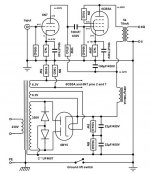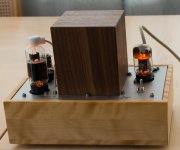Hi, there is a 6EM7 PP in post #403. Seems a nice one to try. I wonder if the OPT is a 5K/8 Ohm ? ..
He have published some books.
I think there are 2 designs of 6BM7pp in one of book.
It is just slightly humorous to think that two valves in parallel make an effects machine but the same two in series miraculously turn "high fidelity reproduction".
Well, we've been talking about two EL500's (or their Russian equivalents) which clearly are in parallel (PSE) in the related schematics. If we put them in series, we have a PP design, resembling those Philips OTL designs with a pair of EL86's.Due to dynamic driver induced distortion (.2 - 2% typical), fidelity at voltage of amp output does not correlate linearly with acoustic distortion. From your POV, I assume that you have never compared measured acoustic fidelity of PP to SE.
It's obvious that SE measures differently from PP. But what comes closer to a true reproduction in the sense of the »wire with gain«? To answer this, have a look at the datasheets. Almost any power tube sheet reads much lower THD in PP than in SE.
Best regards!
Almost any power tube sheet reads much lower THD in PP than in SE.
Only at high power. And mostly because of even harmonic suppression.
Since when is THD so important anyway? If one pursues the route of lowest THD then SS with extreme levels of NFB is the way to go.
THD as low as possible *is* important in order to avoid any »sound signature« - unless your goal is an effects device, e.g. a guitar amplifier (see the related branch in DIYAudio.com). The amplifiers we appear to be discussing here are, or at least should be, true sound reproducers, not sound producers.
Now I see that I'm going to repeat myself again and again…😱
Best regards!
Now I see that I'm going to repeat myself again and again…😱
Best regards!
At correct polarity, the 2nd harmonic of the SE will cancel some of 2nd harmonic generated by a dynamic driver producing higher acoustic fidelity compared to PP. OTOH PP will perform better on an ESL. AFAIK, no datasheet shows measurement of acoustic distortion. Again, amplifier THD figure does not correspond linearly to the fidelity of the acoustic output.... Almost any power tube sheet reads much lower THD in PP than in SE.
Last edited:
Hi-Fi used to be the aspiration, now that's been achieved every effects box needs a USP, oh sorry "sound signature". Repeat yourself if you want but you won't change people's minds.THD as low as possible *is* important in order to avoid any »sound signature« - unless your goal is an effects device, e.g. a guitar amplifier (see the related branch in DIYAudio.com). The amplifiers we appear to be discussing here are, or at least should be, true sound reproducers, not sound producers.
Now I see that I'm going to repeat myself again and again…😱
Best regards!
Too sad that DF96 has passed away recently. He is missing soo much when it comes to discussions like these.
Best regards!
Best regards!
At correct polarity, the 2nd harmonic of the SE will cancel some of 2nd harmonic generated by a dynamic driver ..
Has this been measured? Not disagreeing, a transfer function is a transfer function. Even harmonic cancellation in electronic devices is easy to demonstrate. At first glance it shouldn't matter if the transfer function's output is acoustical instead of electrical.
Unlike decades ago, today's sound card, microphone and analyzer software are quite cheap. Anyone who cares about fidelity needs to take distortion measurement at the acoustic output because that is the fidelity that matters. What is there to discuss?... discussions like these...
Yes, see post #35 ClassB+a mosfet amplifier.Has this been measured? ...
Thanks. Glad to see consideration of different routes to maximizing end-point linearity. My understanding is canceling even harmonics should increase odd harmonics. It's beyond the scope of this thread and a long while since I looked into this but:Yes, see post #35
unexpected harmonic cancellation
Back to the regularly scheduled thread.
Right, there's nothing to discuss when it comes to measurements. We're getting numbers that remain numbers. But that guy swaggers about »sound signatures«. Most probably he believes that his ears are the most reliable measuring devices 🙄.Unlike decades ago, today's sound card, microphone and analyzer software are quite cheap. Anyone who cares about fidelity needs to take distortion measurement at the acoustic output because that is the fidelity that matters. What is there to discuss?
Best regards!
this is a very interesting thread, the Japs have been at it for the longest time now....
i think it was SY who first called SET amps an effects box....
i miss the debates between SY and Thorstein....very animated...
but my vote goes to SY, better and more solid arguments...
straight wire with gain has been a holy grail as far as amplifier builds go,
no end in sight?
but as Nelson Pass put it, this amplifier business is one big entertainment industry...
a one giant circus, with its share of acrobats, clowns and magicians and what have you...
i think it was SY who first called SET amps an effects box....
i miss the debates between SY and Thorstein....very animated...
but my vote goes to SY, better and more solid arguments...
straight wire with gain has been a holy grail as far as amplifier builds go,
no end in sight?
but as Nelson Pass put it, this amplifier business is one big entertainment industry...
a one giant circus, with its share of acrobats, clowns and magicians and what have you...
Last edited:
And I agree, which effect is potentially beneficial to a dynamic driver. OTOH, low THD PP amp can also serve as an effects box since it preserves dynamic driver induced distortion as pristine as possible, best to use it for ESL or other low THD exotics. 🙂... i think it was SY who first called SET amps an effects box....
I'd like to encourage members to augment listening impressions with measurements of fidelity aspects on the acoustic side, should entail more meaningful insights and fruitful discussions. Hopefully then more people can cooperate to push fidelity of audio reproduction a little bit further.
There remains a few other less explored acoustic distortion reduction technique such as H3 cancellation and current feedback for PP topology. As an idea, the Firstwatt SIT3 triode-pentode PP implemented in tubes is interesting.
Last edited:
indra1,
Can you give an example of:
"There remains a few other less explored acoustic distortion reduction technique such as H3 cancellation".
How is that accomplished?
Doing a partial cancellation of 2nd Harmonic Distortion using an SE amplifier and loudspeaker is well established.
But cancellation of 3rd harmonic distortion by using an amplifier and loudspeaker,
not anything I now about.
Thanks!
Can you give an example of:
"There remains a few other less explored acoustic distortion reduction technique such as H3 cancellation".
How is that accomplished?
Doing a partial cancellation of 2nd Harmonic Distortion using an SE amplifier and loudspeaker is well established.
But cancellation of 3rd harmonic distortion by using an amplifier and loudspeaker,
not anything I now about.
Thanks!
If you take a look at post #35 ClassB+a mosfet amplifier you can see Diego has also managed to reduce acoustic H3. Since driver generated H3 tends to be compressive I believe it was reduced by inherent expansive transfer function of class AB PP. It is probably easier to control H3 counter effect by H2 feedback similar to the WE86 and WE92, but I have yet to spend some time with it.... How is that accomplished?...
Which I found odd. Even order cancellation is straightforward and easily demonstrated in electronics. It seems plausible the same can occur when the second stage's output is acoustic; i.e a speaker. Pre-distortion with the necessary phase relationships to cancel odd and even harmonics is harder to grasp...Diego has also managed to reduce acoustic H3.
Yes, that is probably why it is less explored. I have only seen Aaron Nadell, Steve Bench, Lynn Olson and Diegomj1973 mentioned any effort on reduction of H3.
..Back to the regularly scheduled thread.
Yes please Diyers let's keep this thread about schematics sources with tubes 🙂
We can find some interesting ones and build guides on
VinylSavor: Low Cost Single Ended 6CB5A Amplifier - Part 1
some work was inspired by Sakuma San.
Best regards
Attachments
Sorry to go OT for a second, how about starting a thread on the subject pooling what you know into one place?Yes, that is probably why it is less explored. I have only seen Aaron Nadell, Steve Bench, Lynn Olson and Diegomj1973 mentioned any effort on reduction of H3.
- Home
- Amplifiers
- Tubes / Valves
- Gold mine of DI¥ audio tubes schematics from Japan

